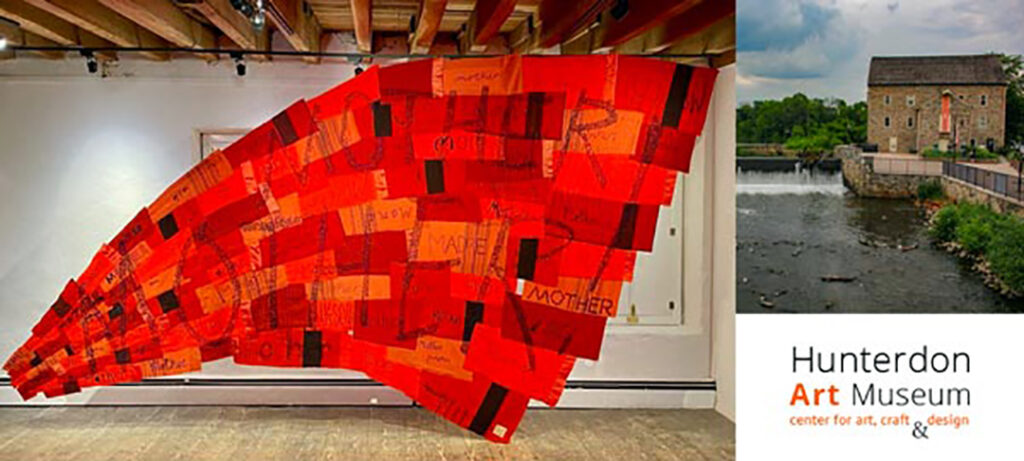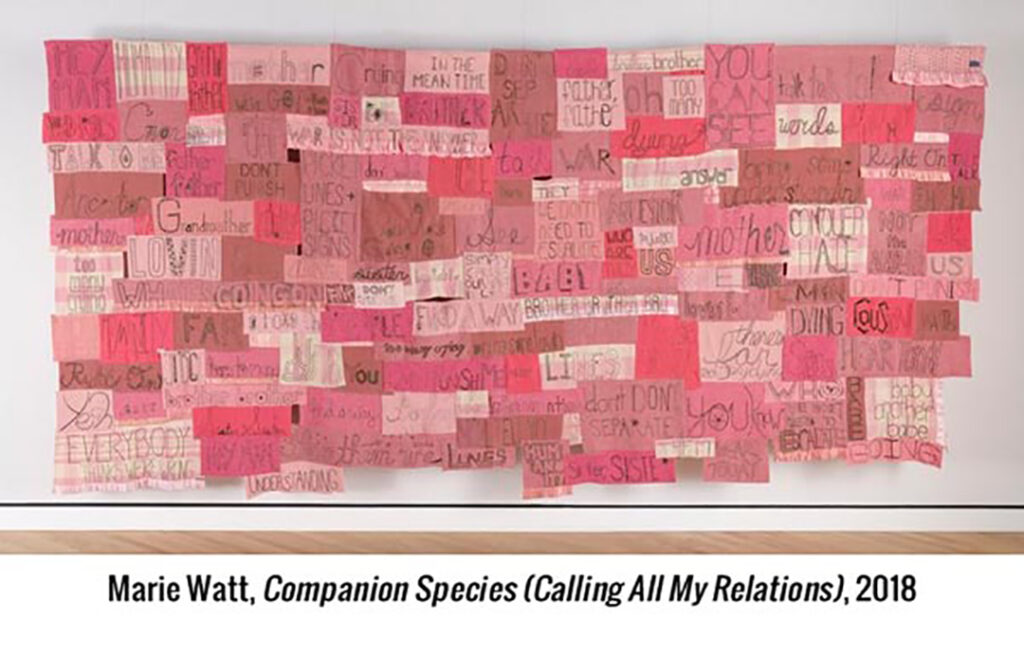Every Blanket Tells a Story and Every Stitch is a Unique Voice in the World of Seneca Nation Artist Marie Watt, On View at the Hunterdon Art Museum
December 21, 2021 | newjerseystage.com

It’s the time of the year when many of us feel like hibernating, perhaps under a favorite blanket or two. It seems fitting, then, that the Hunterdon Museum of Art is featuring the artist Marie Watt, known for her totemic assemblages of wool blankets, in the exhibition Companion Species (At What Cost): The Works of Marie Watt, on view through January 9, 2022.
A blanket offers comfort, protection, and security. It’s what we come into this world in, the artist notes, and we often go out wrapped in one. Watt believes that blankets provide access to social connections, historical traditions, and cross-cultural meanings.
In Native American communities, blankets are given away to honor people for being witnesses to important life events. For this reason, it is considered as great a privilege to give a blanket as it is to receive one.

As she collects blankets, Watt also collects stories. Readers may have seen her installations of pastel-colored wool with frayed satin bindings, little data tags attached, in such venues as the Metropolitan Museum of Art, Yale University Art Gallery, the Denver Art Museum, and the Smithsonian Institution’s National Museum of the American Indian. More recently, she has received acclaim for Skywalker/Skyscraper (Axis Mundi), her columnar sculpture of dozens of stacked folded blankets in the Whitney Museum of American Art’s “Making Knowing: Craft in Art, 1950–2019.” In 2017, Watt was Artist in Residence at Philadelphia’s Fabric Workshop and Museum.
“Companion Species” spotlights two monumental tapestries assembled from panels of cloth embroidered during sewing circles, an activity central to Watt’s artistic practice. A citizen of Seneca Nation of Indians, Watt’s textiles emphasize Indigenous teaching and what Watt calls “Iroquois protofeminism” – the recognition of Indigenous matriarchies predating modern feminism by centuries, and their traditions of deep interconnections between people and the Earth.
The very words “companion species,” headlining this exhibition and in many artwork titles, also suggest that connections extend beyond humans: interspecies relationality. Watt notes “in my tribe, we consider animals our first teachers.”
Born in 1967 in Redmond, Washington, to a Seneca mother of the Turtle Clan and a German father whose family owned a ranch in Wyoming, Watt describes herself as “half Cowboy and half Indian.” Interviewed by phone, she describes her Portland, Oregon, studio where she’s worked for the past 15 years:
“At 3 p.m. the light is beautiful. There are two giant windows that look out onto a train yard. I’m five-foot-three and can only see the tops of the box cars, loaded on the backs of trains.”
With ceilings 14-feet high – nearly three times her height – there is open storage for her artwork. I want to know how she stores all the masses of blankets that form her “palette.”
She organizes them in racks. “When I started collecting them, my focus was wool. It was not an aesthetic judgment; it’s what was available in thrift stores for under $5. I try not to buy for reasons of taste.”
She is interested in the stories the blankets have to tell. “I lean into their stains and moth-eaten bits. I see these as the beauty marks.” And while these details are what are important to Watt, she learned that to prevent moth damage, all the blankets need to be cleaned before coming into the studio.
“I was originally drawn to wool for the way it packs down, and because our animal relatives the sheep have extraordinary stories. People take the time to mend wool.”
Her collecting coincided with the advent of manufactured fleece, but “fleece doesn’t have the sense of permanence and resilience.” At first, people were deaccessioning their wool blankets in favor of fleece, but, over time, many have relearned the value of wool, making the wool blankets hard to come by in thrift stores.
Watt’s racks are categorized by color family, “like tubes of paint when I need a color or a pattern, what speaks to me will come off the rack.”
Sewing circles entered Watt’s practice 18 years ago. “I never anticipated doing it more than a year. Originally, I considered it to be like a barn raising, in which many hands make light work, and people were happy to roll up their sleeves. I would acknowledge their help by feeding them or giving a small, limited-edition print.”
“I like to say that I set the table (with pre-threaded needles and panels for sewing text into) and what happens is created by everyone in the space,” says Watt. “When eyes are diverted and working with cloth, stories flow. It’s intergenerational, cross disciplinary, intercultural. We all have so much to learn from one another. At our core, we have a need for intimacy – sitting down with neighbors and strangers.”
Watt distinguishes sewing circles from sewing bees, which were used to colonize women and girls. The sewing circles are open to anyone, with little or no sewing experience (the marks of those with limited experience can be more expressive, she says). Participants have ranged in age from 3 to 92.
“I’ve always appreciated how everyone’s stitch is a thumbprint, a signature. Sewing with embroidery thread is like a drawing material.”
A sewing circle associated with the Hunterdon exhibition will be held at the Marc Strauss Gallery in New York on January 16, and participants are asked to read the poem “Singing Everything” by U.S. Poet Laureate Joy Harjo, a member of the Muscogee Nation and the first Native American Poet Laureate. Participants should then ask themselves, “What in this moment do I want to sing a song for?” These are the words that will be stitched into panels. And yes, each participant will get a small print.
When asked what, in this moment, she wants to sing for, Watt responds, “Today, I’m going to say teenagers. I have a kid who just turned 17 and I’m grateful for them. I’m thinking about glaciers and Turtle Island and gray skies out the window.”
The Hunterdon Art Museum is located at 7 Lower Center Street in Clinton, New Jersey.
Source:








